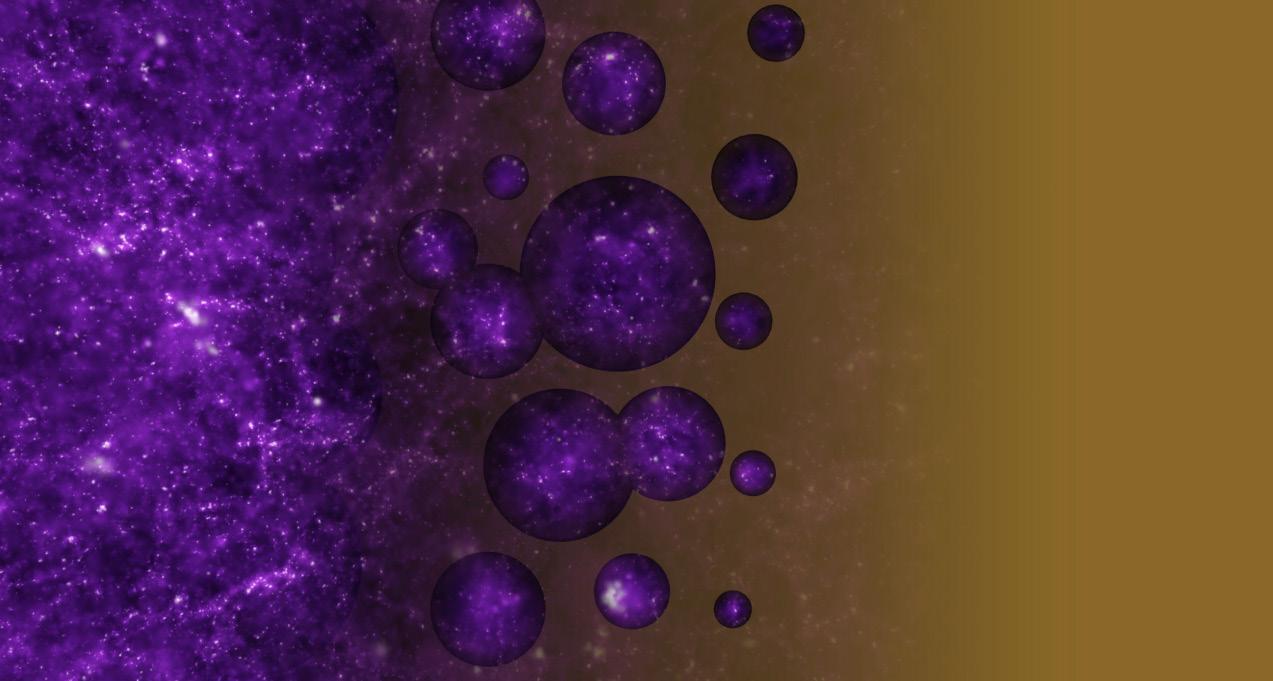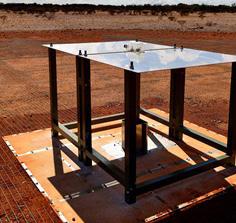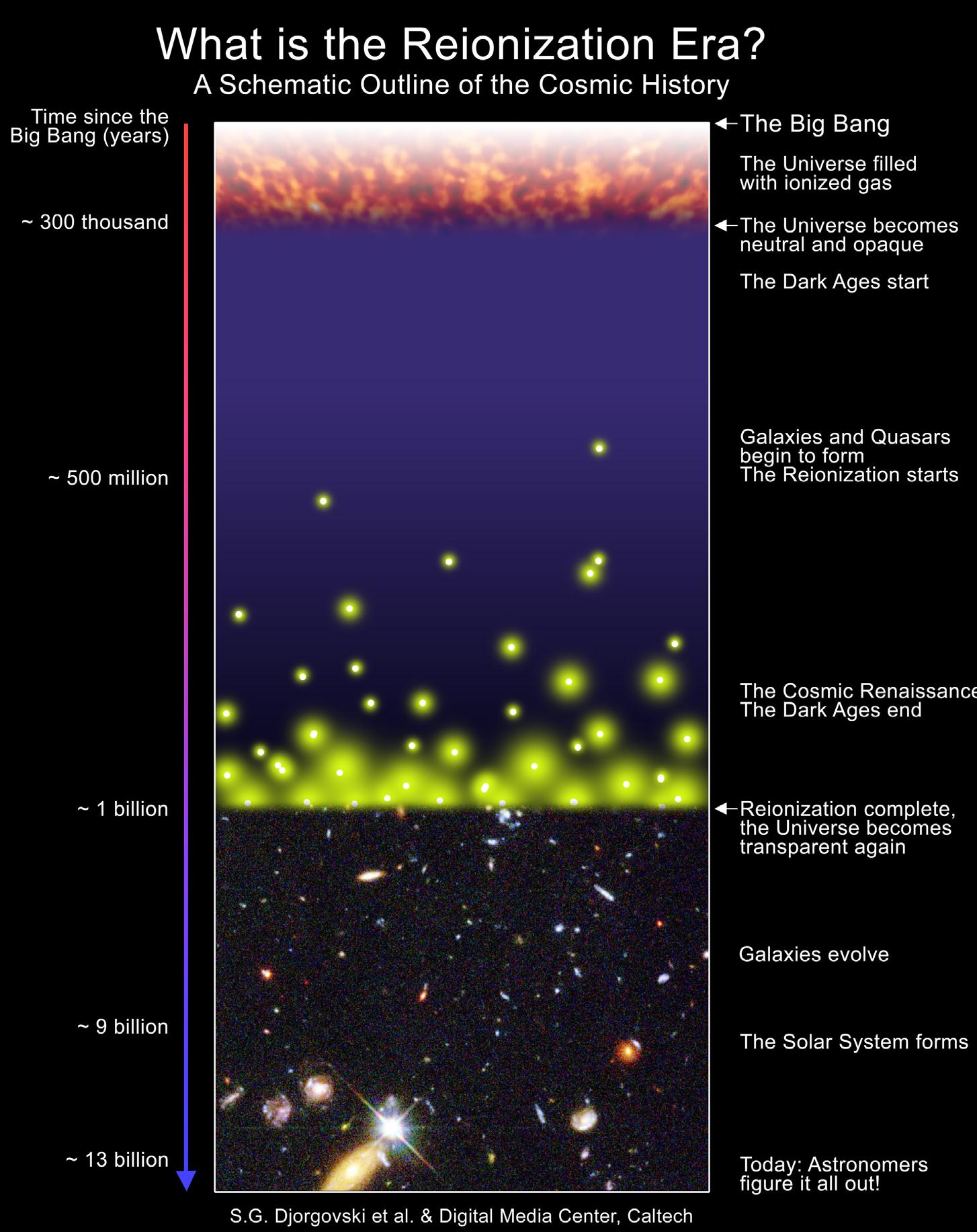
12 minute read
Let’s talk about... the dawn of the Universe
from Contact 08
BY CASSANDRA CAVALLARO (SKAO)
If we cast our minds back to the early 1990s, astronomers involved in the early days of the SKA project were beginning to think about an ambitious goal: to look back further into the history of the Universe than ever before, to the time when the very first stars and galaxies began to light up the darkness. This was the Cosmic Dawn.
That goal would require the detection of signals so faint that many considered it impossible, and indeed it would require major advances in technology to achieve.
“Detection of the faint signal of hydrogen from the infant Universe will be transformational to our understanding of the foundations on which the entire currently visible Universe is built.”
It doesn’t get much more emphatic than that statement from Prof. Leon Koopmans of Kapteyn Astronomical Institute in the Netherlands, an expert in this field.
In the period following the Big Bang, 13.8 billion years ago, the Universe entered an era that we refer to as the Dark Ages. With no starlight, and full of neutral hydrogen, it was an extremely dark, bleak place. That began to change with the Cosmic Dawn, as gravity caused small pockets of gas to collapse and form the first stars and galaxies.
Let’s quickly remind ourselves of some high school physics. Hydrogen is the most abundant element in the Universe. In its neutral state it comprises one electron and one proton; they are in balance, so there is no electrical charge. If that balance is upset, the atom becomes charged, or ionised.
During the Cosmic Dawn the ionisation process began. The first stars and stellar remnants emitted ultraviolet, Lyman-alpha and X-ray radiation, which together caused the neutral hydrogen in and between galaxies to warm up and start absorbing background radiation from the Big Bang, known as the Cosmic Microwave Background. This process created bubbles of ionised gas which gradually grew until they joined up. This period is called the Epoch of Reionisation (EoR).
Astronomers want to directly observe the full imprint from these processes. Using highly sensitive radio telescopes, they aim to look back in time and detect the signal from neutral hydrogen in the intergalactic medium during the early Universe and map its distribution over hundreds of millions of years.
"Light travels at a constant velocity, and the photons emitted during the EoR can be observed here on Earth today, so we are able to effectively look back in time and reconstruct that period in the Universe,” says SKAO Project Scientist Dr Jeff Wagg.

The EoR, in the middle of this image between the Big Bang on the right, and present day on the left, was characterised by bubbles of ionised gas forming and gradually joining over time.
CREDIT: NASA/STScI
To date, there has only been one tentative detection of neutral hydrogen from the Cosmic Dawn period (more on that shortly), so most of the current thinking is based on theoretical predictions and computational models.
“The Planck satellite has given us the most recent and high precision view of the Cosmic Microwave Background, but we know very little about what happened between that point and the time when the first galaxies were forming,” Jeff explains. “Mapping the neutral hydrogen during the EoR and Cosmic Dawn would allow us to better understand this period, and this is a big motivating factor for the SKA-Low telescope, to actually make these measurements and verify whether or not the predictions are correct.”
Neutral hydrogen emits at a wavelength of 21cm, which equates to a frequency of 1420 MHz in the radio part of the electromagnetic spectrum. Simple enough to detect if you are standing close to it, but because the Universe is expanding that wavelength is “stretched” as it travels across space in a process known as redshift. That means that we observe it at lower frequencies here on Earth: the higher the redshift, the further the radio wave has travelled. Astronomers view this as a line (the “21cm line”) and while they are not totally sure when the Epoch of Reionisation occurred, based on current evidence they believe it should mostly be below 200 MHz, an area covered by SKA-Low.
DID YOU KNOW – COSMIC DAWN vs EOR
Until the Epoch of Reionisation, the hydrogen in the Universe was generally colder than the Cosmic Microwave Background.During the EoR, for the first time it was warmer than that background radiation. This is regarded as the transition from the Cosmic Dawn to the Epoch of Reionisation, but astronomers don’t yet know exactly when it happened.
“One the most exciting aspects of studying the Cosmic Dawn/EoR via the redshifted 21cm line is that it opens an entirely new and unexplored era of the Universe, which often leads to very unexpected discoveries,” says Leon, who is also a member of the SKAO’s EoR science working group. “The 21cm line contains an incredible amount of information about the distribution of the gas, where and when it was ionised, how it moved into dark-matter haloes [regions of gravitationally bound matter], what its temperature was (hence how it was heated). This tells us about the first formation of stars, galaxies and black holes.”

Prof. Leon Koopmans
But how does this line tell us so much? What astronomers are able to model, and aim to directly detect, are fluctuations in that 21cm signal, which reflect changes to the physical conditions of the hydrogen gas. When all the gas has ionised the signal will effectively “switch off”. This is very mathematical, but here’s Jeff to break it down for us.
“When you study hydrogen during the EoR, you observe changes in the brightness of the hydrogen between the galaxies, and within different regions of the early Universe. Those changes in brightness occur on three scales: the frequency dimension, which we can think of as different points in time, and the two-dimensional image plane dimension – so at each step in time you’ll have a different image of the gas, and some regions will look brighter than others.”
“The changes could reflect different physical conditions like changes in density of the gas, changes in the neutral fraction of gas (i.e. how much of it has been ionised), or how fast the gas is moving. All of these different physical terms can be reflected in the level of hydrogen ‘brightness’.”
Clear? Let’s plough on…
In Cosmic Dawn studies, the biggest news of recent years came in 2018 when the EDGES experiment, a US-funded project located at the SKA-Low telescope site in Western Australia, announced a possible detection of hydrogen from 180 million years after the Big Bang. That would be a signal from the Cosmic Dawn. The result is still being followed up and confirming it is not an easy task. Part of the challenge is disentangling it from everything else the telescope can see.
“It requires the removal of a very bright foreground signal [from our own galaxy and other galaxies], that can be about 10,000-times brighter than the signal of interest,” Leon says. “Very small instrumental effects also need to be controlled, so much of the debate currently focuses on whether what has been detected is correctly interpreted. Small changes in the foreground and instrument models can have a large impact on the remaining and faint 21cm signal.”
“The EDGES signal is hard to explain with standard physics. If confirmed, it almost certainly would need new physics, or leads to a previously unknown population of radio sources at very high redshifts, for which currently no credible explanation exists,” Leon adds.
One surprising interpretation of the result (aside from it being achieved by a telescope which looks like a simple tabletop) was that it suggests the Universe was twice as cold as had been predicted in this period.
DID YOU KNOW?

The deceptively simple-looking EDGES telescope
CREDIT: MIT Haystack Observatory
The EDGES experiment result did not look for individual signals from a specific direction. Instead it took measurements from across the whole sky and created an average measurement. Read more about the result here: https://tinyurl.com/37xyydwm
While the hunt for a verified direct detection continues, astronomers do have another method for studying this period, by observing the brightness of the light from the early stars and galaxies. This tells us how many photons they sent into the surrounding hydrogen, allowing astronomers to make estimates about the effect on the surrounding gas and how it was ionised. Even in the last couple of decades these types of studies have led to huge shifts in what we think happened during this period.
“Evidence is increasing from various studies that reionisation occurred relatively ‘late’ in the Universe, possibly only really ending at redshifts of 5-6, when the Universe was only around a billion years old,” Leon explains. “This is in sharp contrast to 15-20 years ago, when this was thought to happen around redshift of ~20, or roughly 200 million years old.”

It is now thought that reionisation ended when the Universe was around one billion years old.
CREDIT: S. G. Djorgovski et. al & Digital Media Center, Caltech.
Indirect methods have their limits though, as the light from such distant objects becomes increasingly faint. That means much more sensitive low-frequency radio telescopes, including SKA pathfinders LOFAR, MWA, HERA and NenuFAR, and eventually culminating with SKA-Low, will be key to exploring these distant realms. One thing they all have in common is deceptively simple looking receivers which are small and low to the ground. So how could they detect such a faint signal?
Their power comes as a collective: thousands of small antennas – 131,072 for SKA-Low – which create a huge collecting area and the ability to see a large volume of the Universe.
“The larger the volume of the Universe that is observed, the more signal fluctuations can be observed, and hence the higher the significance of the signal that can be achieved,” Leon explains.“There’s also a benefit to placing the receivers in a compact configuration, so all arrays – MWA, LOFAR, NenuFAR, HERA, and SKA-Low – have a very compact core with many receivers that try to observe as much of the Universe as possible.”
As with much in radio astronomy, and particularly when dealing with such faint signals, interference from artificial sources can be a problem. Not an insurmountable one, though. This part of the spectrum is heavily used by society (FM radio broadcasts use low frequencies), so you can mitigate this by building your telescope in radio quiet zones like the Murchison Radio-astronomy Observatory, future home of SKA-Low in Western Australia. That leaves the problem of airborne interference: satellites and planes.
“Most of this can be removed thanks to data processing techniques, but actually even with LOFAR, in the 100 to 200 MHz frequency range only a few percent of the data contain strong radio frequency interference (RFI), and that is in the middle of Europe, hence a much ‘noisier’ location than the site of SKALow,”Jeff points out.“This kind of RFI – from airplanes, for example – has quite predictable characteristics so can be excised from the data quite effectively.”
Of course, with several telescopes already on the hunt for this signal, it’s possible that one of them could make a confirmed detection first. But SKA-Low is seeking to do much more, mapping the whole period, adding detail that cannot be matched elsewhere. One advantage for SKA-Low in particular is that bigger telescopes have a better noise-to-signal ratio – noise being all the foreground astronomical objects and artefacts in the data caused by the telescope itself. SKA-Low will be so large that this noise will be less apparent, while the EoR signal should appear stronger than in current telescopes, making it “easier” to extract.

SKA-Low promises to revolutionise EoR studies.
CREDIT: SKAO
“SKA-Low will undoubtedly transform the field – it is a giant leap forward in sensitivity and design over all current instruments. This sensitivity will enable SKA-Low to directly image the 21cm signal and the ionised bubble around ionising sources – no other instrument will be able to do this,” Leon says.
“Enormous progress is being made in particular due to more sophisticated data processing and analyses methods developed over the past years. SKA will greatly benefit from this work, but it also emphasises that the success of radio astronomy these days is as much the result of good design but also good software and algorithms. SKA will build on the shoulders of the pathfinder and precursors, and the decades of preparation by all teams.”
While radio astronomy is the key to unlocking much of this period via the 21cm line, to get the fullest picture will require combining results with facilities operating in other parts of the electromagnetic spectrum. “One of the main objectives of NASA’s much-anticipated James Webb Space Telescope(JWST)is to detect the first galaxies in the infrared, and it will be able to estimate their redshifts well into the EoR,”Jeff says. “ALMA is also contributing to these studies, and soon large ground-based optical telescopes like the European ELT will do so as well. Detecting the intergalactic hydrogen gas is where the SKA comes in.”
The JWST is anticipated to be as groundbreaking as the Hubble Space Telescope, but it will only be able to see a fraction of the sky compared to SKA-Low, and only radio astronomy can see into the deepest reaches of the Universe.
Here’s a tantalising thought to end on. Being Earth-bound places some limits on the lowest-frequency studies regardless of the size of a telescope, because the combination of the ionosphere and radio frequency interference make it nearly impossible to observe the Universe below 50 MHz – corresponding to the most distant redshifted hydrogen signals. You know what that means…
“The next steps are going into space,” Leon says. “Some astronomers – including me – are starting to look at observations of the Dark Ages which preceded the Cosmic Dawn, which are probably only accessible via the 21cm lines, since no stars or stellar remnants had formed by then. This will require instruments in the radio-shadow of the Moon, either in orbit or on the lunar surface.”
Those first steps are already being taken. In 2018, China’s Chang’e 4 mission delivered the NetherlandsChina Low-Frequency Explorer to the Moon, three radio antennas that will be pathfinders for any future lunar observatory. And in April this year NASA granted funding to enable further investigations on the proposed Lunar Crater Radio Telescope, an early concept for a radio telescope on the far side of the Moon. It seems the next 10 years could change everything in this exciting field.










